Biography of William "Longsword" Longespee Earl Salisbury 1176-1226
Paternal Family Tree: Anjou aka Plantagenet
Maternal Family Tree: Amice Gael Countess Leicester 1168
In 1150 [his father] King Henry "Curtmantle" II of England (age 16) was created Duke Normandy by Louis VII King Franks (age 30).

On 18 May 1152 Whit Sunday [his father] King Henry "Curtmantle" II of England (age 19) and Eleanor of Aquitaine Queen Consort Franks and England (age 30) were married at Poitiers Cathedral [Map]. They were more closely related than Eleanor and her previous husband Louis VII King Franks (age 32). The marriage would bring the Kingdom of England, and the Duchies of Normandy and Aquitaine under the control of King Henry "Curtmantle" II of England (age 19). She the daughter of William "Saint" Poitiers X Duke Aquitaine and Aenor Chatellerault Duchess Aquitaine. He the son of Geoffrey Plantagenet Duke Normandy and Empress Matilda (age 50). They were half third cousins. He a grandson of King Henry I "Beauclerc" England. 


On 25 Oct 1154 King Stephen I England (age 60) died at Priory of St Martin, Dover [Map]. His first cousin once removed [his father] King Henry "Curtmantle" II of England (age 21) succeeded II King England.

Around 1176 William "Longsword" Longespee Earl Salisbury was born illegitimately to King Henry "Curtmantle" II of England (age 42) and Ida Tosny Countess Norfolk (age 20).

Around Dec 1181 Roger Bigod 2nd Earl Norfolk (age 37) and [his mother] Ida Tosny Countess Norfolk (age 25) were married. He the son of Hugh Bigod 1st Earl Norfolk and Juliana de Vere.


On 06 Jul 1189 [his father] King Henry "Curtmantle" II of England (age 56) died at Chinon Castle [Map]. William Mandeville 3rd Earl Essex Count Aumale was present. He was buried at Fontevraud Abbey [Map]. His son [his half-brother] King Richard "Lionheart" I of England (age 31) succeeded I King England.

In 1196 William "Longsword" Longespee Earl Salisbury (age 20) and Ela of Salisbury 3rd Countess of Salisbury (age 9) were married. He by marriage Earl Salisbury. She the daughter of William of Salisbury 2nd Earl Salisbury (age 46) and Eleanor Vitre Countess of Salisbury (age 38). He the illegitmate son of King Henry "Curtmantle" II of England and Ida Tosny Countess Norfolk (age 40).

Around 1207 [his daughter] Ida Longespée was born to William "Longsword" Longespee Earl Salisbury (age 31) and Ela of Salisbury 3rd Countess of Salisbury (age 20) at Salisbury. She a granddaughter of King Henry "Curtmantle" II of England.
On 08 Dec 1207 [his son] William Longespée was born to William "Longsword" Longespee Earl Salisbury (age 31) and Ela of Salisbury 3rd Countess of Salisbury (age 20). He a grandson of King Henry "Curtmantle" II of England.
On 30 May 1213 William "Longsword" Longespee Earl Salisbury (age 37) accidentally encountered a large French fleet. The French crews were mostly ashore. The English captured around 300 ships at anchor, burning a further 100 ships. The battle resulted in a period of peace in England with France being unable to invade, as well as generating significant wealth for England.
Around 1216 [his son] Stephen Longespée was born to William "Longsword" Longespee Earl Salisbury (age 40) and Ela of Salisbury 3rd Countess of Salisbury (age 29) at Salisbury. He a grandson of King Henry "Curtmantle" II of England.
Before 1220 [his son-in-law] William Beauchamp (age 35) and [his daughter] Ida Longespée (age 12) were married. The difference in their ages was 22 years. She the daughter of William "Longsword" Longespee Earl Salisbury (age 43) and Ela of Salisbury 3rd Countess of Salisbury (age 32). She a granddaughter of King Henry "Curtmantle" II of England. 

Around 1222 [his daughter] Ida II Longespée was born to William "Longsword" Longespee Earl Salisbury (age 46) and Ela of Salisbury 3rd Countess of Salisbury (age 35) at Salisbury. She a granddaughter of King Henry "Curtmantle" II of England.
In 1226 [his son-in-law] William Vesci and [his daughter] Isabella Longespée were married. She the daughter of William "Longsword" Longespee Earl Salisbury (age 50) and Ela of Salisbury 3rd Countess of Salisbury (age 39). She a granddaughter of King Henry "Curtmantle" II of England. 

On 07 Mar 1226 William "Longsword" Longespee Earl Salisbury (age 50) was fatally poisoned by Hubert de Burgh Count Mortain 1st Earl Kent (age 56) at Old Sarum [Map]. Salisbury Cathedral [Map].

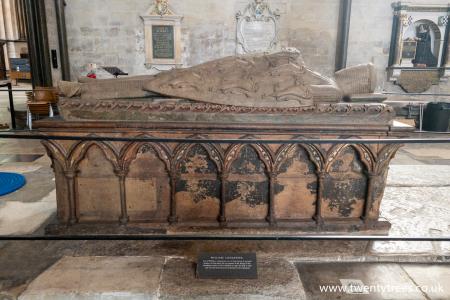
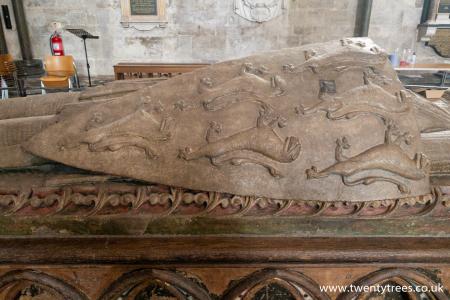
Effigy of William Longespee. WILLIAM Longespee was the bastard son of Henry the Second by the celebrated Rosamund de Clifford [Note. William is now believed to be the son of Ida Tosny Countess Norfolk; a charter William made that mentions "Comitissa Ida, mater mea" (Countess Ida, my mother)]. His half-brother, Richard the First, gave him in marriage Ela, daughter and inheritrix of William Earl of Salisbury. He bore a conspicuous part in the domestic divisions in the reign of King John, whose general he was against the rebellious Barons in 1215, but in the following year went over to the party of Louis the son of the French king. On the death of John he abandoned the cause of Louis, did homage to the young King Henry the Third, and united with William Mareschal, the spirited Earl of Pembroke, then Regent, in raising the siege of Lincoln. In 1219 he was with other English noblemen at the siege of Damietta, which place was vigorously defended by the Saracens, and the capture of which cost the Christian forces very dear. In 1224 he went over into Gascony with Richard Earl of Cornwall, to subdue certain towns and castles to obedience to King Henry their Lord. Returning in the following year they were over-taken at sea by a violent tempest; after beating about for many nights and days they were carried far out of their course; and, giving themselves up for lost, committed all their treasure and rich garments to the deep. While they remained in darkness and despair, on a sudden the whole vessel was illuminated by the brilliant flame of a huge wax taper, which appeared on the prow, and by it a damsel of exceeding beauty, who protected the light with her garment from the force of the wind and rain. While the crew were lost in wonder at this miraculous nocturnal vision, the Earl of Salisbury proclaimed that their thanks were due to the Blessed Virgin for this merciful interposition, at whose shrine, on the day of his knighthood, he had offered a taper to be kept constantly burning on the daily celebration of the offices to her honour. The courage of the dispirited crew revived, and the following morning they made the Isle of Rhé, near Rochelle. Salisbury was speedily obliged to put to sea again, being informed of the design of the Lord of the place to make him prisoner. He braved the adverse elements for three months longer before he reached England. Such is the relation of Matthew Paris. His long absence gave occasion to a current report that he was lost at sea, and Hubert de Burgh, Justiciary of England, solicited to be allowed to match a kinsman of his, one Raymond, who had a claim to the Earldom of Salisbury, with his rich widow, but she, like another Penelope, rejected this suitor. At length the Earl landed unexpectedly in Cornwall, and demanded satisfaction of the King against Hubert, whose relative had assailed the honour of his wife. Hubert made submissive reparation by presents, but is reported to have taken the Earl off by poison, administered to him at a feast to which he had invited him in simulated reconciliation.




Chronica Majora. About the same time, Earl Richard, the king's brother, Earl G. Marshal, John, earl of Chester and Lincoln, the earl of Salisbury [Note. Unclear as to who this is referring since the last Earl of Salisbury William "Longsword" Longespee Earl Salisbury died in 1226 and his wife Ela of Salisbury 3rd Countess of Salisbury, de jure Earl of Salisbury, remained unmarried], G. de Lucy, his brother, Richard Seward, and many other nobles, assumed the cross. Earl Rchard at once ordered his woods to be cut down and sold, and endeavoured by all the means in his power to raise money to sustain his pilgrimage. Not long afterwards, by means of Simon de Montfort, earl of Leicester, and (as was reported) Peter de Eivaulx, Richard Seward unjustly incurred the king's anger, and was taken and imprisoned; but was soon afterwards released with the same ease.


Ralph Somery and [his daughter] Ida Longespée were married. She the daughter of William "Longsword" Longespee Earl Salisbury and Ela of Salisbury 3rd Countess of Salisbury. She a granddaughter of King Henry "Curtmantle" II of England. 
[his daughter] Isabella Longespée was born to William "Longsword" Longespee Earl Salisbury and Ela of Salisbury 3rd Countess of Salisbury. She a granddaughter of King Henry "Curtmantle" II of England.
Walter Fitzrobert and [his daughter] Ida II Longespée were married. She the daughter of William "Longsword" Longespee Earl Salisbury and Ela of Salisbury 3rd Countess of Salisbury. She a granddaughter of King Henry "Curtmantle" II of England. 

[his daughter] Pernel Longespée was born to William "Longsword" Longespee Earl Salisbury and Ela of Salisbury 3rd Countess of Salisbury. She a granddaughter of King Henry "Curtmantle" II of England.
[his daughter] Ela Longespee Countess Warwick was born to William "Longsword" Longespee Earl Salisbury and Ela of Salisbury 3rd Countess of Salisbury. She a granddaughter of King Henry "Curtmantle" II of England.
[his son] Bishop Nicholas Longespée was born to William "Longsword" Longespee Earl Salisbury and Ela of Salisbury 3rd Countess of Salisbury. He a grandson of King Henry "Curtmantle" II of England.
[his daughter] Mary Longespée was born to William "Longsword" Longespee Earl Salisbury and Ela of Salisbury 3rd Countess of Salisbury. She a granddaughter of King Henry "Curtmantle" II of England.
[his son] Richard Longespée was born to William "Longsword" Longespee Earl Salisbury and Ela of Salisbury 3rd Countess of Salisbury. He a grandson of King Henry "Curtmantle" II of England.
Pershore Abbey [Map]. Early Medieval. Monument possibly to William de Harley. Left Leg Over Right. Sword in Left Hand. Holding a horn in his right hand. Fine band around his head. Head on single cushion.
Detailed description from Mark Downing of the Church Monuments Society posted to Facebook; abridged:
This limestone effigy lies flat on its back on a stone coffin, and is positioned in the middle of the south transept. The legs are missing below the knees. The figure is represented cross-legged (left over right). Below the head is a single rectangular cushion.
It wears a mail hauberk, mitten gauntlets and a coif all made in one. There is a cord around the head, above the face-opening, passing through rings of mail at wide intervals. A triangular flap which can be seen on the left side of the neck, represents the part of the mail coif called a ventail. This was a flap of mail drawn across the mouth to close the face-opening, and was secured to the temple either by a strap and buckle, or by a knotted cord. The mail of the armour is rendered by parallel rows of C's, alternate rows having the curves lying in the opposite directions. The rows of mail run around the coif, arms and hauberk. The left arm is partially concealed underneath the shield with the palm of the hand resting on top of the pommel of the sword. The right hand is bare, with the mitten-gauntlet off the hand, hanging loose around the wrist. The hand is holding a hunting horn at hip level, which has a strap passing through the lower-ring of a figure eight terminal. This strap is then attached around the horn at its rear and centre. Attached to the upper ring of the terminal is a loose strap which may have been used to suspend the horn from either the sword-belt or a baldric, the loose end falling underneath the hand.
Clearly shown within the opening of the gown, beneath the arm is an additional underlying body-defence. This almost certainly represents a coat of plates, joined together at the side by three straps with rectangular buckles, the straps emerging from within the upper-breast: the rivets would have been painted on. An effigy in the Temple church, London, is wearing a similar plate defence. The coat of plates consisted of a poncho-like garment with either a solid breast-plate sewn into it, or a series of metal plates attached by rivets to a textile cover. Visible at the neck, in the aperture of the coif, is a smooth garment. Presumably this represents the upper-chest portion of the coat of plates described above.
Worn over the coat of plates is a long sleeveless gown reaching to the calf, with the front open in the usual V-fashion. On the left arm, suspended from a guige which passes diagonally across the chest and over the right shoulder, is a long kite-shaped shield, which is concave towards the body. The shield is plain with no traces of heraldry present. Biting the tip of the shield is a damaged creature, possibly a griffin, dragon or wyvern.
The sword belt which has a square buckle is decorated with I-shaped bars, having a circular boss in their centres. The belt is attached to the scabbard by a single band. The loose portion of the belt falls to the thigh. The pommel of the sword is virtually concealed by the left hand. The grip is of medium length and the remains of the right quillon is worn. The sword, in its scabbard, lies at an angle on the left side of the figure, its tip broken.
Covering the knees and the lower part of the legs are mail hose. The mail represented in the same manner as on the coif and arms. Shown below the left knee is a strap, intended to stop the mail sagging down the leg.
Unfortunately the effigy has been damaged and has lost the lower part of the legs. A drawing by Thomas Dingley in the seventeenth century shows the effigy complete with an animal resting below the feet. The drawing also shows that originally stiff-leaf foliage was represented running along the right-hand edge of the slab, similar to that of William Longespèe ob.1227 (Wiltshire) Salisbury Cathedral [Map].
In 1838 the effigy was found buried on the north side of the church, with the stone coffin placed beneath it. Thomas Habington recorded the effigy on the north side of the quire, also with a hare at his feet which is now missing.
As previously mentioned a serpent or dragon is biting the point of the shield. The theory as to why these creatures are represented on monuments is not fully understood, but may derive from Psalm 91, v. 13. 'Thou shalt tread upon the lion and adder: the young lion and the dragon, shalt thou trample under foot'. These type of creatures are found on effigies in the North-East of England, for example at Egglesclffe, (Durham), Fountains Abbey [Map] c.1325 and Bainton c.1320-40, (both Yorkshire). It must be remarked that the Pershore effigy is not related to the examples found in the North-East as can be observed on stylistic grounds. Lawrence Stone remarks on a Westminster-Lincoln stylistic connection which may carry some weight, but as the effigy is so singular it is very difficult to attribute it to any single group. However the upper-drapery is not too dissimilar to work at Worcester Cathedral [Map] (q.v.), and Alfred C. Fryer has attributed both Worcester (1) and Pershore to the 'Bristol Workshop'.
A very unusual feature is the presence of a horn which is held in the right hand. Other effigies known to the writer where horns are represented can be seen for instance at: Glinton (Northamptonshire) c.1300-1325, Newland (Gloucestershire) c.1457, Skegby, (Nottinghamshire) c.1300 and Wadworth (Yorkshire), c.1300, all are dressed in civilian clothes whereas the Pershore effigy is represented in armour. The reason why the Pershore effigy is represented with a horn is open to at least two theories. The traditional belief is that he was a forest ranger or warden of the Kings forest. The second is that he held land by the horn, 'horngeld'. A splendid medieval oliphant horn known as 'The Savernake Horn' is preserved in the British Museum, London, which has silver enamelled mounts decorated with hunting dogs, forest animals, a seated King, a bishop and a forester. It is thought to have once belonged to the Sturmy family who were hereditary wardens of the Savernake forest from the early twelfth century until the first quarter of the fifteenth century and would add most weight to the theory of the Pershore effigy being a forest warden.
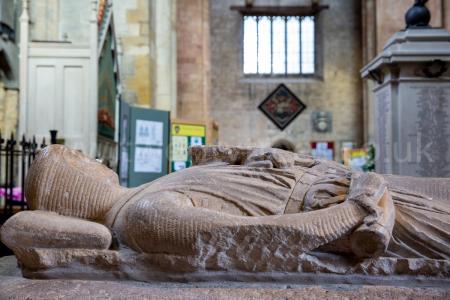
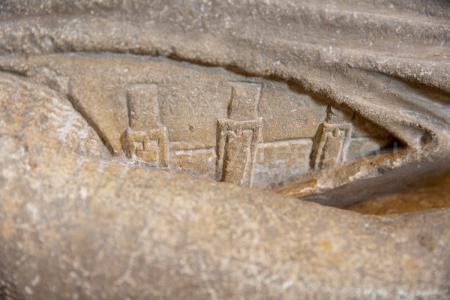
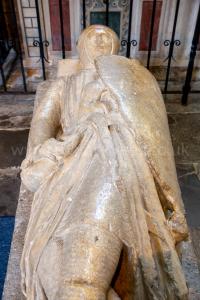
Kings Wessex: Great x 4 Grand Son of King Edmund "Ironside" I of England
Kings England: Son of King Henry "Curtmantle" II of England
Kings Scotland: Great x 2 Grand Son of Malcolm III King Scotland
Kings Franks: Great x 10 Grand Son of Louis "Pious" King Aquitaine I King Franks
Kings France: Great x 4 Grand Son of Robert "Pious" II King France
Philippa Lancaster Queen Consort Denmark x 1
Joan Beaufort Queen Consort Scotland x 1
King Richard III of England x 4
Anne Neville Queen Consort England x 4
King Henry VII of England and Ireland x 1
Queen Anne Boleyn of England x 6
Anne Jagiellon Holy Roman Empress x 1
Catherine Parr Queen Consort England x 7
Queen Catherine Howard of England x 5
Jane "Nine Days Queen" Grey I Queen England and Ireland x 12
President George Washington x 2
Queen Elizabeth II of the United Kingdom x 955
Queen Consort Camilla Shand x 350
Diana Spencer Princess Wales x 3009
Great x 4 Grandfather: Hugh de Perche Count Gâtinais
Great x 3 Grandfather: Geoffrey "Ferréol" Anjou 2nd Count Gâtinais
Great x 4 Grandmother: Béatrice de Mâcon Countess Gâtinais
Great x 2 Grandfather: Fulk "Réchin" Anjou 4th Count Anjou
Great x 4 Grandfather: Fulk "Black" Ingelger III Count Anjou
Great x 3 Grandmother: Ermengarde Blanche Ingelger Duchess Burgundy
Great x 4 Grandmother: Hildegarde Sundgau Countess Anjou
Great x 1 Grandfather: Fulk "Young" King Jerusalem 
Great x 4 Grandfather: Aumary Reginarids
Great x 3 Grandfather: Simon Montfort
Great x 4 Grandmother: Bertrade Unknown
Great x 2 Grandmother: Bertrade Montfort Queen Consort France
Great x 4 Grandfather: Richard Normandy 2nd Count Évreux
Great x 3 Grandmother: Agnès of Normandy
Great x 4 Grandmother: Adelaide or Godehildis Ramon
GrandFather: Geoffrey Plantagenet Duke Normandy 
Great x 3 Grandfather: Jean de la Flèche La Flèche De Baugency
Great x 2 Grandfather: Elias La Flèche De Baugency I Count Maine
Great x 4 Grandfather: Herbert "Wakedog" Maine I Count Maine
Great x 3 Grandmother: Paula Maine
Great x 1 Grandmother: Ermengarde La Flèche De Baugency Countess Anjou
Great x 3 Grandfather: Gervais II Lord Chateau Du Loir
Great x 2 Grandmother: Matilda Chateau Du Loir Countess Maine
Father: King Henry "Curtmantle" II of England  Grand Son of King Henry I "Beauclerc" England
Grand Son of King Henry I "Beauclerc" England
Great x 4 Grandfather: Richard "Good" Normandy II Duke Normandy
Great x 3 Grandfather: Robert "Magnificent" Normandy I Duke Normandy
Great x 4 Grandmother: Judith Penthièvre Duchess Normandy
Great x 2 Grandfather: King William "Conqueror" I of England -2 x Great Grand Son of King William "Conqueror" I of England
-2 x Great Grand Son of King William "Conqueror" I of England
Great x 4 Grandfather: Father of Beatrix and Herleva
Great x 3 Grandmother: Herleva Falaise
Great x 1 Grandfather: King Henry I "Beauclerc" England  Son of King William "Conqueror" I of England
Son of King William "Conqueror" I of England
Great x 4 Grandfather: Baldwin "Bearded" IV Count Flanders
Great x 3 Grandfather: Baldwin "The Good" V Count Flanders
Great x 4 Grandmother: Ogive Luxemburg Countess Flanders
Great x 2 Grandmother: Matilda Flanders Queen Consort England
Great x 4 Grandfather: Robert "Pious" II King France
Great x 3 Grandmother: Adela Capet Duchess Normandy
Great x 4 Grandmother: Constance Arles Queen Consort France
GrandMother: Empress Matilda  Daughter of King Henry I "Beauclerc" England
Daughter of King Henry I "Beauclerc" England
Great x 3 Grandfather: Duncan "The Sick" I King Scotland
Great x 2 Grandfather: Malcolm III King Scotland
Great x 3 Grandmother: Bethóc Unknown Queen Consort Scotland
Great x 1 Grandmother: Edith aka Matilda Dunkeld Queen Consort England 
Great x 4 Grandfather: King Edmund "Ironside" I of England
Great x 3 Grandfather: Edward "The Exile" Wessex
Great x 4 Grandmother: Ealdgyth Unknown
Great x 2 Grandmother: Margaret Wessex Queen Consort Scotland
Great x 3 Grandmother: Agatha
William "Longsword" Longespee Earl Salisbury  Son of King Henry "Curtmantle" II of England
Son of King Henry "Curtmantle" II of England
Great x 4 Grandfather: Roger "The Spaniard" Tosny
Great x 3 Grandfather: Raoul Tosny
Great x 4 Grandmother: Adelaide or Godehildis Ramon
Great x 2 Grandfather: Raoul Tosny
Great x 4 Grandfather: Simon Montfort
Great x 3 Grandmother: Isabelle Montfort
Great x 4 Grandmother: Isabel Bardoul
Great x 1 Grandfather: Roger Tosny 
Great x 3 Grandfather: Waltheof Northumbria 1st Earl of Northampton 1st Earl Huntingdon
Great x 2 Grandmother: Alice Northumbria
GrandFather: Ralph Tosny 
Mother: Ida Tosny Countess Norfolk 
Great x 4 Grandfather: Humphrey "Vielles" Beaumont
Great x 3 Grandfather: Roger "Bearded" Beaumont
Great x 2 Grandfather: Robert Beaumont 1st Earl of Leicester Count Meulan
Great x 3 Grandmother: Adeline Meulan
Great x 1 Grandfather: Robert Beaumont 2nd Earl of Leicester 
Great x 4 Grandfather: King Henry I of France
Great x 3 Grandfather: Hugh "Great" Capet
Great x 4 Grandmother: Anne Rurik Queen Consort France
Great x 2 Grandmother: Elizabeth Capet Countess Leicester, Meulan and Surrey
Great x 4 Grandfather: Herbert Vermandois IV Count Vermandois
Great x 3 Grandmother: Adelaide I Countess Vermandois
GrandMother: Margaret Beaumont 
Great x 4 Grandfather: Ralph "Staller" Gael 1st Earl East Anglia
Great x 3 Grandfather: Ralph de Gael 2nd Earl East Anglia
Great x 2 Grandfather: Raoul Gael
Great x 4 Grandfather: William Fitzosbern 1st Earl Hereford
Great x 3 Grandmother: Emma Fitzosbern Countess East Anglia
Great x 4 Grandmother: Adelise Tosny Countess Hereford
Great x 1 Grandmother: Amice Gael Countess Leicester